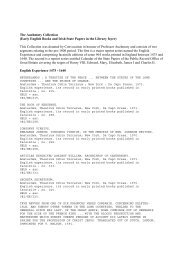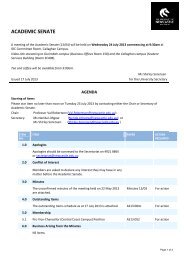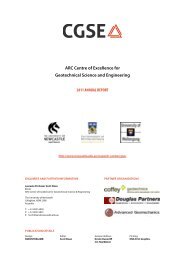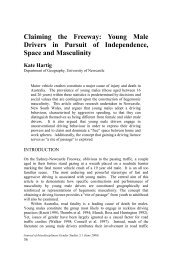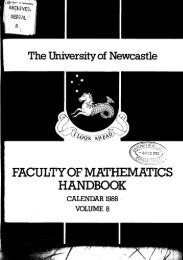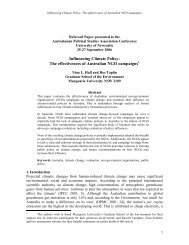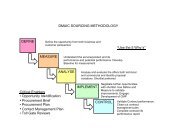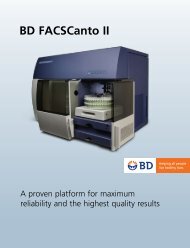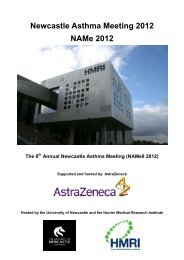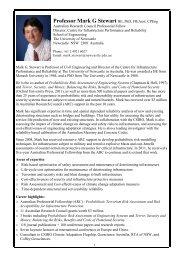Faculty of Mathematic Handbook,1987 - University of Newcastle
Faculty of Mathematic Handbook,1987 - University of Newcastle
Faculty of Mathematic Handbook,1987 - University of Newcastle
Create successful ePaper yourself
Turn your PDF publications into a flip-book with our unique Google optimized e-Paper software.
Examination<br />
Content<br />
One three hour paper and progressive assessment<br />
The course is devoted to a study <strong>of</strong> the various dimensions <strong>of</strong> the evolution and "motion"<br />
<strong>of</strong> the capitalist economic system through time. It considers explanations <strong>of</strong> capital<br />
accumulation and structural change, real economic growth and fluctuations in growth<br />
rates. Specific topics will include expanding reproduction and balanced growth, capital<br />
accumulation and income distribution, short-term fluctuations, long-wave fluctuations and<br />
the role <strong>of</strong> innovations and technological change in growth and fluctuations.<br />
References<br />
Duijn, 1. van<br />
Harris, D.J.<br />
Heertje, A.<br />
Kalecki, M.<br />
Kregel, J.<br />
Lowe, A.<br />
Steindl. J.<br />
(vii) 423115<br />
Prerequisite<br />
Hours<br />
Examination<br />
Content<br />
Topics in International Economics<br />
Economics n<br />
The Long Wave in Economic Life<br />
(Allen & Unwin 1983)<br />
Capital Accumulation and Income Distribution<br />
(Routledge & Kegan Paul 1978)<br />
Economics and Technical Change (Weidenfeld &<br />
Nicolson· 1977)<br />
Selected Essays on the Dynamics <strong>of</strong> the Capitalist<br />
Economy (Cambridge U.P. 1971)<br />
Rate <strong>of</strong> Pr<strong>of</strong>it, Distribution and Growth: Two Views<br />
(Macmillan 1971)<br />
The Path <strong>of</strong> Economic Growth<br />
(Cambridge V.P. 1976)<br />
Maturity and Stagnation in American Capitalism<br />
(Monthly Review Press 1976)<br />
2 lecture hours per week for half the year<br />
One 3-hour paper and progressive assessment<br />
This course provides a more advanced theoretical treatment <strong>of</strong> selected topics introduced<br />
in the International Economics course. It also uses empirical studies and policy materials<br />
to provide a more detailed exposition and analysis <strong>of</strong> trade policy problems. The content<br />
consists <strong>of</strong>:<br />
1. The neo-classical theory <strong>of</strong> international trade and equilibrium. the modem theory <strong>of</strong><br />
trade, its clarification, extension and qualification, the sources <strong>of</strong> economic growth<br />
and international trade, equivalence among trade intervention measures, a general<br />
equilibrium approach to protection, analysis <strong>of</strong> Australian protection policy,<br />
international factor mobility and host country costs and benefits.<br />
2. International monetary economics, the foreign exchange market and the role <strong>of</strong><br />
arbitrage, extension <strong>of</strong> the analysis <strong>of</strong> the flexible exchange rate systems, extension<br />
<strong>of</strong> the analysis <strong>of</strong> fixed exchange rate systems, monetary and fiscal policies for<br />
internal and external balance, a single open economy and two country model,<br />
international monetary reform.<br />
Text<br />
Grubel, H.G. International Economics (Irwin 1981)<br />
106<br />
(viii) 423116 Advanced Economic Analysis<br />
This course is a prerequisite for <strong>Mathematic</strong>slEconomics IV<br />
Prerequisite<br />
Economics II<br />
Hours<br />
2 lecture hours per week<br />
Examination<br />
Two 2-hour papers and progressive assessment<br />
Content<br />
(i) Macroeconomics:<br />
The course covers a series <strong>of</strong> macroeconomic issues in both theory and policy.<br />
These will include the management <strong>of</strong> fiscal policy. discretionary stabilisation policy<br />
in the open-economy situation, the nature <strong>of</strong> "monetarist" and "rational expectations"<br />
based macroeconomics. dimensions <strong>of</strong> the capitalist "stagflation crisis", and the role<br />
<strong>of</strong> price formation and income distribution in the determination <strong>of</strong> economic activity.<br />
(ii) Microeconomics:<br />
The aims <strong>of</strong> this section <strong>of</strong> the course are to consolidate the students' knowledge <strong>of</strong><br />
microeconomics acquired in Economics I and n, to improve the students' depth <strong>of</strong><br />
understanding <strong>of</strong> microeconomics and to extend their knowledge <strong>of</strong> the subject<br />
through the introduction <strong>of</strong> several new topics in the areas <strong>of</strong> COnsumer behaviour<br />
theory, market failure and the role <strong>of</strong> government in the market.<br />
References<br />
(i) Macroeconomics:<br />
Cornwall, J.<br />
Frisch, H.<br />
Kaldor, N.<br />
Mayer, T.<br />
Sawyer, M.e.<br />
Shone, R.<br />
(ii) Microeconomics:<br />
Douglas, E.1.<br />
Ferguson, C.E.<br />
Koutsoyiannis, A.<br />
Tisdell, C.A.<br />
733300 Geology IIIC<br />
Prerequisites<br />
Hours<br />
Examination<br />
The Conditions for Economic Recovery<br />
(Martin Robertson 1983)<br />
Theories <strong>of</strong> Inflation (Cambridge U.P. 1983)<br />
The Scourge <strong>of</strong> Monetarism (Oxford U.P. 1982)<br />
The Struclure <strong>of</strong> Monetarism (Norton 1978)<br />
Macroeconomics in Question: the Keynesian<br />
Monetarist Orthodoxies and the Kaleckian<br />
Alternative (Wheatsheaf 1982)<br />
Issues in Macroeconomics (Martin Robertson 1984)<br />
Intermediate Microeconomic Analysis<br />
(Prentice-Hall 1982)<br />
Microeconomic Theory (Irwin 1972)<br />
Modern Microeconomics 2nd edn<br />
(MacMillan 1979)<br />
Microeconomics <strong>of</strong> Markets (Wiley, Brisbane 1982)<br />
Physics IA. <strong>Mathematic</strong>s IIA, IIC & Geology IIA<br />
3 lecture hours, 6 laboratory hours<br />
per week & 12 days field work<br />
Two 2-hour papers in Geology plus assessment.<br />
Appropriate paper(s) in the selected <strong>Mathematic</strong>s<br />
topic.<br />
107



